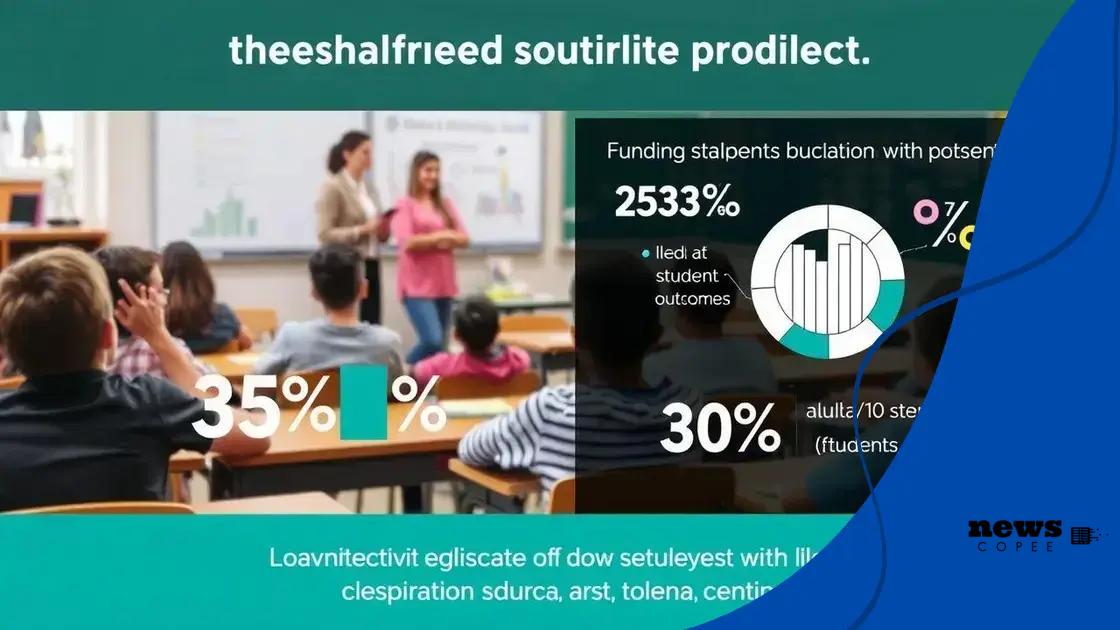Public vs. private school funding debates intensify

Public vs. private school funding debates intensify as crucial discussions focus on achieving equitable educational opportunities and improving student outcomes through collaborative and data-driven funding strategies.
Public vs. private school funding debates intensify, sparking conversations that many parents and educators find crucial. These discussions raise important questions about equity, opportunity, and the future of education. Are we truly providing the best for our children?
Understanding the funding models of public schools
When discussing understanding the funding models of public schools, it’s essential to look at how different sources contribute to school budgets. Public schools rely primarily on government funding, which can vary greatly based on location.
Typically, funding comes from three main sources: local, state, and federal governments. Each level plays a crucial role in the overall financial health of schools.
Local Funding
Local funding is primarily derived from property taxes. This model can create disparities between schools in wealthy neighborhoods versus those in less affluent areas.
- Homeowners in affluent areas pay higher property taxes.
- These funds directly benefit local schools.
- Schools in low-income areas often receive less funding.
State Funding
State funding helps to level the playing field by distributing funds more evenly. However, the method of allocation can vary widely.
- Some states use a formula based on student enrollment.
- Others may focus on the specific needs of districts with lower income.
- This approach aims to support schools that may struggle otherwise.
Despite these efforts, the funding models often fall short, leaving some schools without adequate resources. This issue raises questions about what every child deserves in terms of education.
A deeper understanding of these funding mechanisms is crucial. It can shine a light on inequities and spark conversations about necessary reforms. Ultimately, knowing how public schools are funded may help advocates push for more equitable practices.
The role of private institutions in education funding
Examining the role of private institutions in education funding showcases a complex relationship between public and private sectors. Private institutions often contribute to the overall educational landscape by providing additional funding and resources.
These private entities can offer scholarships, grants, and direct donations to schools in need. Such support can significantly enhance the educational experience for students by providing access to better facilities and programs.
Types of Private Funding
Private funding can take many forms. Understanding these types helps clarify how they support public education.
- Scholarships: Many private organizations provide scholarships to students, helping to alleviate financial burdens.
- Grants: Some institutions offer grants to public schools for specific projects or enhancements.
- Endowments: Wealthy private institutions may establish endowments, creating a long-term funding source for public education.
Impact on Public Schools
The impact of private funding on public schools is multifaceted. On one hand, increased funding can lead to improved programs and opportunities. On the other hand, it may raise questions about equity and fairness.
When private funding flows primarily to wealthier districts, it can widen the gap between affluent and underfunded schools. This discrepancy illustrates the need for balanced funding strategies that ensure all schools can thrive.
Advocates emphasize the importance of collaborating with private institutions while maintaining a focus on equitable access for all students. By fostering partnerships, schools can harness additional resources without sacrificing public accountability.
Impact of funding debates on student outcomes

The impact of funding debates on student outcomes is a crucial aspect of the education discussion. When funds are limited, schools face tough decisions that can greatly affect students.
Research shows that adequate funding directly correlates with better educational results. Schools with more resources typically have higher graduation rates and improved student performance.
Quality of Education
When schools engage in funding debates, it often centers around the quality of education they can provide. Funding influences teacher salaries, class sizes, and available materials.
- Teacher retention: Higher funding allows schools to offer competitive salaries, attracting and keeping qualified teachers.
- Class sizes: More funds enable schools to hire additional staff, reducing the student-to-teacher ratio.
- Resources: Schools with adequate financing can afford better textbooks, technology, and extracurricular activities.
Equity among Students
Funding debates can highlight disparities between schools. Schools in wealthy districts often have more resources than those in low-income areas, affecting equity among students.
Ensuring that all students have access to quality education is vital. When funding is inconsistent, it raises questions about fairness and equal opportunities for every child. Advocates argue that funding should be redistributed to lessen these gaps, promoting a more balanced educational environment.
Understanding the impact of funding debates helps stakeholders make informed decisions that benefit students in the long run. These discussions can shape policies and determine how resources are allocated across the educational landscape.
Community perspectives on school funding equity
Exploring community perspectives on school funding equity reveals diverse opinions and experiences that shape discussions around education. Communities are often affected by how funds are allocated to schools.
Local opinions vary, depending on whether the community is from a wealthy district or a low-income area. These perspectives are crucial in understanding the broader implications of school funding policies.
Voices from Wealthy Districts
In affluent communities, residents may feel that their taxes should directly benefit their local schools. They often advocate for increased funding, believing it results in better educational quality.
- Desire for Excellence: Wealthy communities often push for advanced programs and extracurricular activities.
- Investment in Facilities: Improved facilities are seen as essential for attracting families to the area.
- Emphasis on Outcomes: Parents seek high graduation rates and college readiness for their children.
Voices from Low-Income Areas
Conversely, communities in low-income areas frequently struggle with underfunded schools. Their perspectives highlight the urgency of addressing funding disparities.
- Call for Equal Opportunities: Many advocate for equitable funding to ensure all students have access to quality education.
- Need for Resources: Parents emphasize the necessity of resources like textbooks, technology, and experienced teachers.
- Community Support: Local organizations often work to support schools through fundraising and advocacy.
These contrasting perspectives underline the deep challenges present in achieving school funding equity. Bridging the gap requires active dialogue and collaboration among community members and policymakers to create fair funding practices.
Future trends in school funding policies
Understanding future trends in school funding policies is essential as education needs evolve over time. As the landscape of education changes, funding methods must adapt to meet new challenges.
One significant trend is the shift towards equity-based funding. Policymakers are increasingly recognizing that all students deserve access to quality education, regardless of their background or location.
Increased Focus on Equity
Equity-based funding ensures that resources are allocated where they are needed most. This approach considers the unique challenges faced by individual schools and districts.
- Data-Driven Decisions: Using data to assess needs helps direct funding to the most under-resourced schools.
- Community Input: Engaging communities in discussions about their needs can lead to more effective funding solutions.
- Flexible Funding Models: Implementing funding models that can adjust based on changing demographics and needs helps schools stay relevant.
Emphasis on Technology Integration
Another trend is a greater emphasis on funding for technology in classrooms. Schools are increasingly integrating digital resources to enhance learning experiences.
This shift includes funding for devices, online learning platforms, and infrastructure improvements. Schools that embrace technology tend to foster more engaging learning environments.
As these trends evolve, there will likely be a push for more comprehensive funding strategies. This may involve collaboration between public and private sectors to diversify funding sources and ensure sustainability.
Overall, staying informed about future trends in school funding policies will help stakeholders advocate for necessary changes that can positively impact students and their educational outcomes.
In conclusion, the discussions surrounding school funding are vital for shaping the future of education. Understanding the dynamics of public vs. private funding, the role of community perspectives, and the impact of these debates on student outcomes can lead to more equitable solutions. As we strive for better funding policies, it’s essential to focus on collaboration among stakeholders and adapt to emerging trends. By ensuring all students have access to quality education, we pave the way for a brighter future.
FAQ – Frequently Asked Questions about School Funding
What are the main sources of school funding?
The primary sources of school funding are local, state, and federal governments, with local taxes playing a significant role.
How does funding affect student outcomes?
Adequate funding typically correlates with better educational results, including higher graduation rates and improved student performance.
What is equity-based funding?
Equity-based funding aims to allocate resources based on the specific needs of schools, ensuring that all students have access to quality education.
How can communities get involved in funding discussions?
Communities can engage through public meetings, advocacy groups, and surveys to express their needs and priorities regarding school funding.
